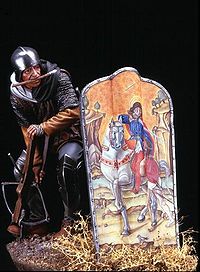miheikki
Greatest Leader
Eikös jalkajousen käyttö aiheuttanut vastalauseita muinaisten ammattisoturien piirissä? Siinä kuitenkin suhteellisen pienen koulutuksen saanut soturi pystyi taistelemaan ammattimiestä vastaan tehokkaasti. Paavi ainakin kielsi kristittyjä käyttämästä sitä toisiaan vasten (kenenkähän pyynnöstä)
Jostain muistan lukeneeni, että nämä piikkimurrosteet aiheutti myös sanomista.
Medieval Europe[edit]
A Medieval crossbowman drawing his bow behind his pavise. A hook on the end of a strap on his belt engages the bowstring. Holding the crossbow down by putting his foot through the stirrup, he draws the bow by straightening his legs
The crossbow is portrayed as a hunting weapon on four Pictish stones from early medieval Scotland (6th to 9th centuries): St. Vigeans no. 1, Glenferness, Shandwick, and Meigle.[49] The use of crossbows in European warfare is again evident from the Battle of Hastings until about the year 1500. They almost completely superseded hand bows in many European armies in the 12th century for a number of reasons.
In modern tests, longbows showed a higher rate of shot than crossbows of the same energy, due to the difficulty of the shooter in handling the mechanical parts for loading in the same time as the bow was pulled. With lots of training, a longbowman can achieve a high degree of accuracy that is comparable to the much steeper learning curve in aimed shooting with the crossbow. Despite strength training, there are physical limits to the longbow, unlike the crossbow, which can store several times the energy, but will be less efficient in translating stored into kinetic energy due to the thicker spring material. There is no record from the Middle Ages comparing longbowmen and crossbowmen shooting in one army from a similar position, although such occasions are known with visiting Englishmen in the Baltic and Scots in the French army.
In the armies of Europe,[50] mounted and unmounted crossbowmen, often mixed with slingers, javelineers and archers, occupied a central position in battle formations. Usually they engaged the enemy in offensive skirmishes before an assault of mounted knights. Crossbowmen were also valuable in counterattacks to protect their infantry. The rank of commanding officer of the crossbowmen corps was one of the highest positions in any army of this time. Along with polearm weapons made from farming equipment, the crossbow was also a weapon of choice for insurgent peasants such as the Taborites.
Mounted knights armed with lances proved ineffective against formations of pikemen combined with crossbowmen whose weapons could penetrate most knights' armor. The invention of pushlever and ratchet drawing mechanisms enabled the use of crossbows on horseback, leading to the development of new cavalry tactics. Knights and mercenaries deployed in triangular formations, with the most heavily armored knights at the front. Some of these riders would carry small, powerful all-metal crossbows of their own. Crossbows were eventually replaced in warfare by more powerful gunpowder weapons, although early guns had slower rates of fire and much worse accuracy than contemporary crossbows. Later, similar competing tactics would feature harquebusiers or musketeers in formation with pikemen (pike and shot), pitted against cavalry firing pistols or carbines.
Legal issues[edit]
Main article: Laws on crossbows
Modern competition crossbow
Can. 29 of the Second Lateran Council under Pope Innocent II in 1139 banned the use of crossbows, as well as slings and bows, against Christians.[74]
Jostain muistan lukeneeni, että nämä piikkimurrosteet aiheutti myös sanomista.
Caltrop
From Wikipedia, the free encyclopedia
For the plant or its fruit, see water caltrop and Tribulus terrestris.
Roman caltrop at Westfälisches Museum für Archäologie, Herne, Germany
A caltrop (also known as caltrap, galtrop, cheval trap, galthrap,[1] galtrap, calthrop, jackrock or crow's foot[2][3]) is an antipersonnel weapon made up of two or more sharp nails or spines arranged in such a manner that one of them always points upward from a stable base (for example, a tetrahedron). Caltrops were part of defenses that served to slow the advance of horses, war elephants, and human troops. They were particularly effective against the soft feet of camels.[4] In more modern times, caltrops are still effective when used against wheeled vehicles with pneumatic tires.
The modern name "caltrop" is derived from the Latin calcitrapa (foot-trap),[5] such as in the French usage chausse-trape. The synonymous Latin word tribulus gave rise to the modern Latin name of a plant, Tribulus terrestris (Zygophyllaceae), whose spiked seed case can injure feet and puncture tires. This plant can also be compared to the starthistle, Centaurea calcitrapa, which is sometimes referred to as the "caltrop". A water plant with similarly-shaped spiked seeds is called the "water caltrop", Trapa natans.





